Steam rises from mint tea glasses at Plaza Feddan as dawn breaks over Tétouan’s whitewashed medina. The call to prayer mingles with church bells in a harmony most tourists never hear. It’s 6:47 AM in November 2025, and this UNESCO World Heritage city of 380,787 residents reveals its deepest secret. While millions crowd Fez’s commercialized souks and pay inflated Marrakech prices, Morocco’s “White Dove” quietly protects 500 years of Andalusian heritage from the summer masses.
When the “White Dove” reveals what tour buses miss
Arriving through Bab Al-Okla gate at 8 AM feels like stepping into a living museum. The medina’s 150 hectares of narrow lanes glow amber under Rif Mountain light. Temperatures hover at a perfect 63°F, compared to summer’s brutal 91°F heat that drives locals indoors.
Only 250,000 annual visitors discover this Andalusian refuge, a fraction of Fez’s overwhelming millions. The contrast hits immediately: Tétouan’s whitewashed walls with turquoise zellige accents versus Fez’s chaotic brown density. This ancient capital costs 30% less than Morocco’s imperial cities while offering authentic encounters tourists elsewhere never experience.
Local artisans arrive at workshops by 6:30 AM when Mediterranean breezes carry orange blossom scents through empty alleys. Tour groups won’t appear for three hours, leaving the medina to residents who’ve perfected their morning rituals over centuries.
The Andalusian secret locals guard since 1492
Tétouan’s cultural revelation unfolds slowly for those who understand its history. Andalusian refugees rebuilt this city after the Reconquista, creating a unique Spain-Morocco fusion invisible to rushed visitors.
Architecture that whispers two continents
The “White Dove” nickname reflects more than aesthetics. Traditional Tétouan white carries a slight blue tint for heat reflection, a technique perfecting by Andalusian architects. Carved wooden doors showcase Spanish colonial influence from the 1913-1956 protectorate period.
The Spanish Quarter (Ensanche) reveals red-tiled roofs alongside Moorish minarets in visual harmony. These fortress-like structures demonstrate architectural authenticity that commercialized kasbahs have lost to tourism.
Where Spanish and Arabic still blend daily
Sixty-eight percent of residents over 60 speak Spanish fluently, a living legacy most tourists never encounter. The former Spanish church, now a Cultural Center, sits just 300 meters from the Grand Mosque. This religious coexistence reflects Tétouan’s deeper character.
UNESCO’s Creative Cities designation in 2017 protects 87% of traditional craft workshops from commercialization. Anti-gentrification policies limit souvenir shops to 15% of medina businesses, preserving authenticity that Marrakech’s tourist quarters abandoned decades ago.
What locals actually do at 7 AM (tourists sleep through this)
The real Tétouan experience happens before 10 AM when golden hour illuminates white walls without harsh shadows. Local rhythms reveal themselves to early risers willing to abandon typical vacation schedules.
The real medina experience: before 10 AM
Arrive at Plaza Feddan by 7:30 AM to watch bread delivery to neighborhood households. The Ethnographic Museum’s orange-tree courtyard offers morning silence broken only by fountain sounds. Leather artisans welcome respectful visitors into workshops where 127 multi-generational families continue traditional crafts.
Like Athens’ golden-hour monuments, Tétouan’s white facades achieve their most photogenic moments between 6:47 and 8:30 AM. Tourists arriving at 10 AM face harsh noon glare and crowded alleys.
Where locals eat: $3 tagines tourists never find
Neighborhood cafes outside the tourist medina serve traditional breakfasts for $2.40-3.40. Café Al Andalus on Rue Mohammed V buzzes with locals sharing msemen bread with honey before work begins. Mediterranean proximity brings seafood tagines unavailable in inland Fez.
The Central Market opens at 6 AM, but locals finish shopping by 9 AM before tourist groups arrive. Tuesday and Friday fruit markets in Place Al Qods offer authentic glimpses of daily life that guidebooks overlook.
Why November beats summer by 62% (temperature and crowd math)
November 2025 brings perfect 54-68°F temperatures while summer’s 77-100°F heat empties the medina during midday hours. Crowd density drops 65% compared to August peak season, returning Tétouan to its residents.
The 2025 Andalusian Music Festival (November 15-22) showcases cultural depth Instagram crowds never discover. Heritage accommodations offer 20-30% savings during shoulder seasons when locals reclaim their medina streets.
According to regional tourism data, spring and fall visitors report 40% higher satisfaction rates than summer tourists. The mathematics are simple: comfortable temperatures plus authentic interactions equal Morocco as locals actually live it.
Your questions about Tétouan’s hidden heritage answered
How do I actually get to Tétouan from the U.S. in 2025?
Fly into Tangier Ibn Battouta Airport via European connections (10-14 total hours), then take a 90-minute taxi ($17-21) or bus ($6.30-7.30) to Tétouan. No direct flights serve the city’s small Sania Ramel Airport. Spring (April-June) and fall (September-November) offer ideal 59-77°F weather with 40% fewer crowds than peak summer.
What makes Tétouan different from Fez or Marrakech culturally?
Andalusian architectural heritage creates visual harmony unlike Fez’s commercial chaos or Marrakech’s tourist saturation. The Spanish colonial Quarter coexists with the Moroccan medina, while 212 traditional craftspeople receive subsidized materials under UNESCO protection programs. Religious coexistence and Spanish language preservation reflect authentic multicultural heritage.
Is Tétouan actually cheaper than other Moroccan destinations?
Yes, accommodation costs 20-30% below national averages. Mid-range riads charge $39-54 per night versus Marrakech’s inflated rates. Local neighborhood meals cost $2.40-6 compared to tourist restaurant prices of $12-15. Museum entries average $3, and guided Rif Mountain hikes cost $21-53. Authenticity keeps prices reasonable because tourism isn’t the primary economy.
The muezzin’s final call fades across Plaza Feddan as morning light climbs white medina walls. An artisan locks his zellige workshop, mint tea ritual complete. You’ve discovered what 380,787 residents quietly protect: Morocco’s Andalusian soul, still breathing in narrow lanes where tour buses never venture and crowds never slow enough to truly see.
